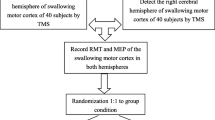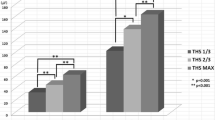Abstract
The aim of this study was to assess the effects of ice applied to the oral cavity on the excitability of corticobulbar projections to the swallowing muscles. The subjects were 8 healthy adult volunteers (mean age 29.0 ± 4.9 years). Motor-evoked potentials (MEPs) were recorded from the suprahyoid muscle complex using surface electrodes. Two blocks of 20 MEPs with a test stimulus intensity of 120% of the resting motor threshold were recorded at rest (baseline). Subjects then underwent 5-min thermal stimulation by either of 3 different types: (1) “ice-stick inside mouth,” (2) “ice-stick on neck,” and (3) “room temperature inside mouth.” Blocks of 20 MEPs were then recorded immediately and at 5-min intervals for the following 15 min. There was a significant difference in the effects of the 3 interventions on the amplitude of the MEPs following stimulation (two-way ANOVA: INTERVENTION × TIME; F8,84 = 3.76, p < 0.01). One-way ANOVA was used to evaluate the changes over time for each intervention type. Only “ice-stick inside mouth” caused an increase in the MEPs (one-way ANOVA main effect of TIME: F4,28 = 4.04, p = 0.010) with significant differences between baseline and P10 (mean difference 0.050; confidence interval (CI) 95% 0.019–0.079; p = 0.004). There were no significant effects of either “ice-stick on neck” or “room temperature inside mouth” (F4,28 = 1.13, p = 0.36; F4,28 = 1.36, p = 0.27, respectively). Ice stimulation within the oral cavity increases the excitability of the cortical swallowing motor pathway.


Similar content being viewed by others
References
Miller AJ. Deglutition. Physiol Rev. 1982;62:129–84.
Thexton AJ. Mastication and swallowing: an overview. Br Dent J. 1992;173:197–206.
Jean A, Car A. Inputs to the swallowing medullary neurons from the peripheral afferent fibers and the swallowing cortical area. Brain Res. 1979;178:567–72.
Ertekin C, Kiylioglu N, Tarlaci S, Keskin A, Aydogdu I. Effect of mucosal anaesthesia on oropharyngeal swallowing. Neurogastroenterol Motil. 2000;12:567–72.
Mansson I, Sandberg N. Effects of surface anesthesia on deglutition in man. Laryngoscope. 1974;84:427–37.
Hamdy S, Aziz Q, Rothwell JC, Singh K, Barlow J, Hughes D, Tallis RC, Thompson DG. The cortical topography of human swallowing musculature in health and disease. Nat Med. 1996;2:1217–24.
Hamdy S, Aziz Q, Rothwell JC, Hobson A, Thompson DG. Sensorimotor modulation of human cortical swallowing pathways. J Physiol. 1998;506:857–66.
Fraser C, Rothwell JC, Power M, Hobson A, Thompson D, Hamdy S. Differential changes in human pharyngoesophageal motor excitability induced by swallowing, pharyngeal stimulation, and anesthesia. Am J Physiol Gastrointest Liver Physiol. 2003;285:137–44.
Mistry S, Rothwell JC, Thompson DG, Hamdy S. Modulation of human cortical swallowing motor pathways after pleasant and aversive taste stimuli. Am J Physiol Gastrointest Liver Physiol. 2006;291:666–71.
Selçuk B, Uysal H, Aydogdu I, Akyuz M, Ertekin C. Effect of temperature on electrophysiological parameters of swallowing. J Rehabil Res Dev. 2007;44:373–80.
Michou E, Mastan A, Ahmed S, Mistry S, Hamdy S. Examining the role of carbonation and temperature on water swallowing performance: a swallowing reaction-time study. Chem Senses. 2012;37:799–807.
Logemann JA. The dysphagia diagnostic procedure as a treatment efficacy trial. Clin Commun Disord. 1993;3:1–10.
Lazzara G, Lazarus C, Logemann JA. Impact of thermal stimulation on the triggering of the swallowing reflex. Dysphagia. 1986;1:73–7.
Ali GN, Laundl TM, Wallace KL, DeCarle DJ, Cook IJ. Influence of cold stimulation on the normal pharyngeal swallow response. Dysphagia. 1996;11:2–8.
Sciortino K, Liss JM, Case JL, Gerritsen KG, Katz RC. Effects of mechanical, cold, gustatory, and combined stimulation to the human anterior faucial pillars. Dysphagia. 2003;18:16–26.
Rossi S, Hallett M, Rossini PM, Pascual-Leone A, Safety of TMS Consensus Group. Safety, ethical considerations, and application guidelines for the use of transcranial magnetic stimulation in clinical practice and research. Clin Neurophysiol. 2009;120:2008–39.
Nakamura T, Fujishima I. Usefulness of ice massage in triggering the swallow reflex. J Stroke Cerebrovasc Dis. 2013;22:378–82.
Plowman-Prine EK, Triggs WJ, Malcolm MP, Rosenbek JC. Reliability of transcranial magnetic stimulation for mapping swallowing musculature in the human motor cortex. Clin Neurophysiol. 2008;119:2298–303.
Magara J, Watanabe M, Tsujimura T, Hamdy S, Inoue M. Cold thermal oral stimulation produces immediate excitability in human pharyngeal motor cortex. Neurogastroenterol Motil. 2018;30:e13384. https://doi.org/10.1111/nmo.13384.
Bisch EM, Logemann JA, Rademaker AW, Kahrilas PJ, Lazarus CL. Pharyngeal effects of bolus volume, viscosity, and temperature in patients with dysphagia resulting from neurologic impairment and in normal subjects. J Speech Hear Res. 1994;37:1041–59.
Rosenbek JC, Robbins J, Fishback B, Levine RL. Effects of thermal application on dysphagia after stroke. J Speech Hear Res. 1991;34:1257–68.
Helfrich-Miller KR, Rector KL, Straka JA. Dysphagia: its treatment in the profoundly retarded patient with cerebral palsy. Arch Phys Med Rehabil. 1986;67:520–5.
Jean A. Brainstem control of swallowing: localisation and organisation of central pattern generator for swallowing. In: Taylor A, editor. Neurophysiology of the jaws and teeth, vol. 1. London: MacMillan Press; 1990. p. 294–321.
Al-Toubi AK, Abu-Hijleh A, Huckabee ML, Macrae P, Doeltgen SH. Effects of repeated volitional swallowing on the excitability of submental corticobulbar motor pathways. Dysphagia. 2011;26:311–7.
Author information
Authors and Affiliations
Contributions
MK and JCR contributed to the conception and study design, data acquisition, analysis and interpretation, and drafting of the manuscript. SS and RH contributed to data acquisition and analysis. ST and TF contributed to data acquisition, analysis and drafting of the manuscript. All authors revised the article critically and approved the final version for publication.
Corresponding author
Ethics declarations
Disclosure
JCR and RH were supported by a Medical Research Council Grant (MR/K01384X/1). The other authors declare no conflicts of interest.
Informed Consent
Informed consent was obtained from all participants.
Rights and permissions
About this article
Cite this article
Kawakami, M., Simeoni, S., Tremblay, S. et al. Changes in the Excitability of Corticobulbar Projections Due to Intraoral Cooling with Ice. Dysphagia 34, 708–712 (2019). https://doi.org/10.1007/s00455-018-09975-4
Received:
Accepted:
Published:
Issue Date:
DOI: https://doi.org/10.1007/s00455-018-09975-4




